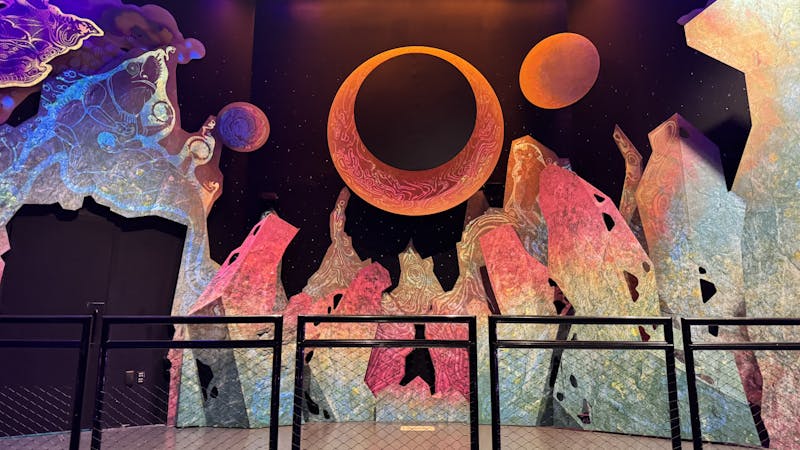Review: “GOLLIWOG” is another billy woods masterpiece

Score: ★★★★★
Top track: “A Doll Fulla Pins” (feat. Yolanda Watson, Jeff Markey and Messiah Musik)
billy woods' “GOLLIWOG” is a magnum opus, a rare rap album that blends trenchant political critique with intimate reflections on trauma. It is a visceral exploration of post-colonial oppression and the psychic residue it leaves behind. woods doesn’t just create a narrative about history; he immerses the listener in its emotional weight, making this album a haunting meditation on survival, loss and resistance.
From the first track, “Jumpscare,” woods sets an ominous tone, layering sound and noise in a way that mirrors a horror movie’s unsettling atmosphere. The track references colonial terror, invoking imperialist Cecil Rhodes and rapping “the English language is violence, I hotwired it.” The distortion of colonial power becomes a central theme throughout “GOLLIWOG,” as woods uses the tools of the oppressor to reflect the pervasive presence of colonialism in everyday life.
This atmosphere of dread lingers, a constant undercurrent shaping the album’s sonic and lyrical landscape. On “STAR87,” a track defined by Conductor Williams' ominous strings, woods shifts focus to the emotional burden of survival. He navigates the tension between homecoming and ruin, reflecting on diaspora, return and the struggle to honor those who came before him. The track’s haunting verse, where woods’ dead friends return to accuse him — “it should’ve been you” — encapsulates the weight of history. Woods is not just recalling past loss; he is grappling with its living, breathing impact on his present identity and music.
The album’s title, “GOLLIWOG,” serves as a pointed symbol of colonial objectification. The golliwog doll, a 19th-century racist caricature, is not merely a historical relic but a representation of how the colonized are reduced to objects. On “A Doll Fulla Pins,” Yolanda Watson’s chilling hook hovering over eerie brass, turns the doll into a haunting figure that transcends nostalgia. woods crafts a chilling narrative of a haunted house, where even the furniture becomes an agent of surveillance. This image is both absurd and terrifying, emphasizing how colonial violence lingers in the most private spaces, never allowing the past to remain buried.
On “BLK ZMBY,” woods examines the post-colonial "zombie states" where the elites have fled or profited, leaving the poor to survive by any means necessary. The track critiques global inequality, juxtaposing the lavish lives of the elite with the desperate struggles of the marginalized. Woods doesn’t deliver a lecture here, but rather a stark, poetic ledger of exploitation: oil must flow, debt must service and a sovereign mask is placed on a captured face. It’s a dissection of how the global systems that shaped colonialism continue to extract from the oppressed.
The recurring motif of the house in woods' work represents the personal and collective legacies of trauma. In “Lead Paint Test,” woods reflects on the physical and emotional damage passed down through generations. The track describes a house where each creak and crack in the plaster echoes with the weight of inherited injury. The house becomes a metaphor for the body, for the psyche, where trauma is embedded in the very walls we inhabit.
The closing track, “Dislocated,” explores the concept of psychic amputation — the feeling of being unmoored and estranged from one’s own identity. Woods invokes Fanon’s vision of colonization as a theft of personhood. “Face pressed to the pavement,” “a knee grinding the spine,” until the refrain becomes a verdict — “I can’t be located.” With this, woods illustrates that the oppression his community has experienced has removed them of personhood and forced them into isolation as protection.
Each of these tracks contributes to the broader narrative of “GOLLIWOG”, where the personal is always intertwined with the political. Woods does not separate his personal experience from the systemic forces that shape it. In every verse, he examines how the weight of history, of violence, and of resistance forms the foundation of his identity. The album creates a space where these themes of trauma and survival collide, making the personal reflections on loss and homecoming inseparable from the larger critiques of colonial and post-colonial systems.
What makes “GOLLIWOG” so powerful is how it ties these themes to a visceral, emotional core. woods doesn’t just describe the structures of power; he explores the lasting effects of these structures on the human soul. The house, the golliwog, the zombie state — each symbol becomes a lens through which we can understand the deep emotional cost of colonialism and its aftereffects. woods anchors these political themes in raw human experience, ensuring that every listener feels the weight of what’s being said, not just intellectually, but emotionally.
In the end, “GOLLIWOG” is more than just an album; it is a meditation on survival in the face of impossible odds, a portrait of the human spirit scarred but unbroken. woods succeeds in balancing the personal and the political, blending his own grief with the collective suffering of the oppressed. He’s furious, precise and unrelenting, crafting a narrative that cuts through the noise of modern rap to offer a searing, personal reflection on the legacies of colonialism and the ongoing struggle for identity and autonomy. The album reads like a novel, with each track acting as a chapter in a larger story about history, trauma and resilience.
More from The Rice Thresher

Thresher’s guide to arts and entertainment in Houston
New to the city? Unsure how to spend your time procrastinating on homework? You’re in luck — Houston is a playground if you know where to look, and most of it is an easy metro ride or short commute from campus. Here’s a starter pack of spots that deliver fresh air, brain food and the occasional “wait, this is in Houston?” moment.

Thresher’s Lollapalooza report: Who ruled Grant Park?
Chicago’s Grant Park ran on pure dopamine this weekend — surprise debuts, late-but-worth-it arrivals, confetti, fireworks and at least three mass sing-alongs an hour. From Joey Valence & BRAE road-testing new indietronica to A$AP Rocky cracking open his vault, T-Pain turning the field into karaoke and Olivia Rodrigo summoning Weezer, Lollapalooza felt like a live-wire mixtape. Doechii built a universe, TWICE made history and Sabrina signed off with a superstar-cementing finale. Here’s what actually lived up to the skyline.
“Ginny & Georgia” Season 3: A Messy, Magnetic Villain Origin Story
I’ll admit it: I came into “Ginny & Georgia” expecting another glossy Netflix soap that looks great in a weekend binge but evaporates from memory by Monday. By the end of season three, I realized I’d been doing something I rarely do with shows like this: I was taking notes. Not on the plot (though it’s as twisty and outrageous as ever), but on the characters. I loved them. I was grinning from ear to ear watching them scheme, stumble and monologue their way through impossible situations. That’s when I knew: this show had done something right.


Please note All comments are eligible for publication by The Rice Thresher.